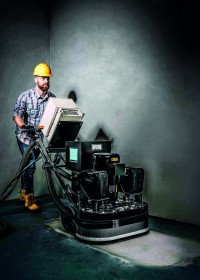Done and dusted
Published: 11 January, 2019
Dave Bigham, director of global training initiatives at surface preparation equipment specialist National Flooring Equipment, discusses the importance of dust collection for manufacturers.
In outer space, cosmic dust is widely present across the galaxy. Originally, it was an annoyance to astronomers – it obstructed the objects they wished to observe. The introduction of infrared astronomy identified that the dust was actually a vital component of astrophysical processes.
Dust is more than just an annoyance for manufacturers, it is also health and safety risk. During construction and renovation in a manufacturing facility, numerous jobs can create dust including surface preparation tasks like grinding, scarifying and shot blasting. It is vital that when the surface is prepared for the replacement floor, dust does not become airborne.
Protecting the people
One reason that dust collection is so important is that airborne dust can lead to serious consequences for anyone in the area. One of the more well-known health consequences of breathing in construction dust is silicosis, caused by silica dust inhalation. In addition, certain surfaces may contain oil, hydraulic fluid or brake fluid, which are carcinogens. When a surface is cut or scraped, these materials are released. Dust can also cause other conditions, such as chronic obstructive pulmonary disease (COPD) and asthma. To make matters worse, once a person’s lungs have been contaminated, they will never recover.
There can be several other negative consequences for manufacturers. For example, if dust were to get behind a control panel in an automotive manufacturing facility, vehicles would have to be taken apart after assembly if they are contaminated. If electronic components became contaminated, it could ruin an entire batch.
Getting the job done
As well as the serious health and safety issues, airborne dust impacts a job’s efficiency. If dust spreads around the site, it can contaminate the walls, doors, air vents and will greatly increases the amount of time required to clean up when the job is complete. This adds time to the renovation job, which increases downtime and the labour cost of the project for the manufacturer.
To remove the risk of these negative consequences, manufacturers should establish early on with the contractor exactly how dust will be managed. This should involve dust collection equipment – it is not acceptable to use a manual broom, as it can increase airborne dust and is against regulations in some regions. The ability to capture dust before it becomes airborne is cleaner, safer and significantly less work.
Don’t let the dust settle
Though it is the contractor’s responsibility to ensure proper dust collection in place, manufacturers can improve their knowledge and understanding to oversee the process and reduce the risk of a costly error. A good way to do this is have a member of the health and safety team working closely with the contractor to ensure the correct measures are in place.
Manufacturers must ensure the contractor is using the correct type of equipment. One important thing to be aware of is that equipment can usually be paired with a specific dust collector, but a good guideline is that a smaller surface preparation machine requires a small dust collector and vice versa.
Dust collection can also be done in two ways, wet or dry. Usually the application at hand will specify whether wet or dry collection is most appropriate. For example, in food processing or the production of electronic components the risk dust poses is huge. In these scenarios, surfaces should be prepared using water to ensure no dust is escaping into the environment, it is instead caught in slurry. This is because dust can cause drastic problems and contaminate products.
Dry dust collection, on the other hand, acts almost like an oversized vacuum cleaner. Where possible, contractors opt for this technology as it requires less labour time, avoids the risk of water meeting electricity and removes the need to clean up slurry. Manufacturers should be aware that this means there will be a low level of airborne dust generated and ensure that the contractor has opted for the correct choice between wet or dry dust collection.
Keep it legal
Because it is so important that dust collection is managed properly, regulations have been introduced to cover dust collection on construction sites. In the US, all dust collectors are required to have a high-efficiency particulate air (HEPA) filter, a secondary filtration system that collects the dust that the main filter doesn’t. The HEPA filter removes the smallest particles, which are often the most dangerous.
As well as legislative requirements on equipment, disposal is a regulated process. The laws for disposal are varied by country and in the US by state, so contractors must take care to follow the local laws and dispose of dust legally. There can be huge fines if a contractor fails to do so. The company must check in to the contractor to ensure these processes are managed correctly or run the risk of breaking the law.
Cosmic dust is present across the galaxy, but construction dust doesn’t have to be airborne across a manufacturing facility. Manufacturers should be aware that dust is more than an annoyance to reduce health and safety risks and improve efficiency.







